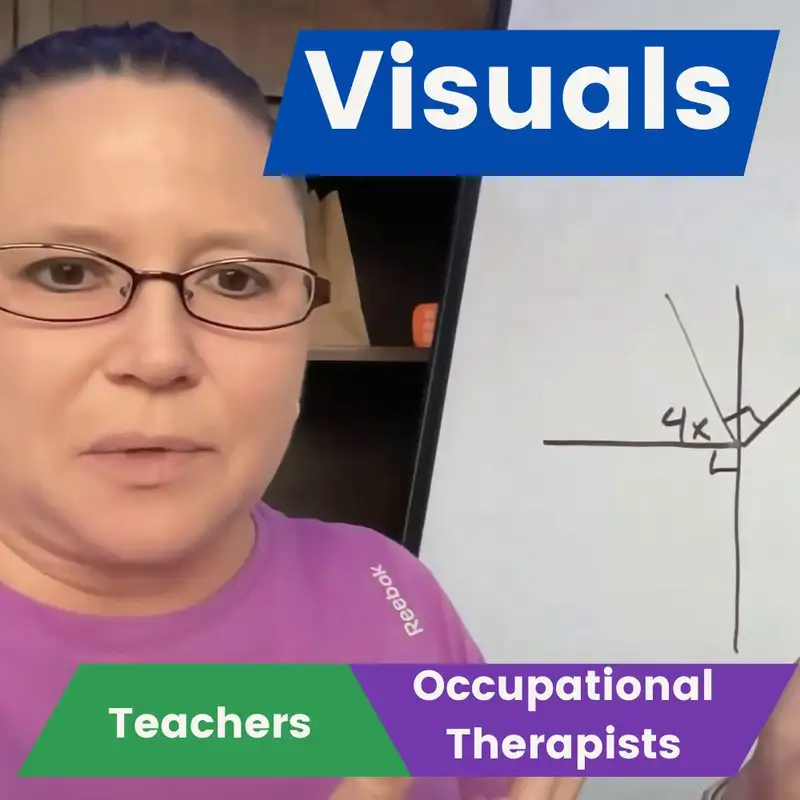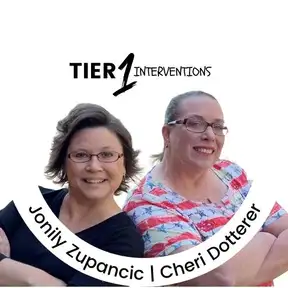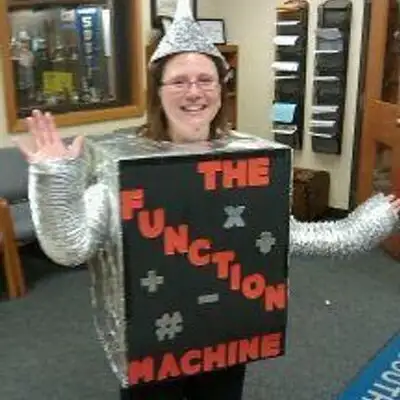
Visual strategies for teachers and occupational therapists: S2 E11
Clips from T1I Jesse & Kay segment 1
===
Speaker: [00:00:00] Good morning.
Jonily: We were looking at a plain stimulus, and they were all test release questions. They had to first write all of the outcomes, so any skill or concept that could be a possibility to be exposed through this stimulus. And then we had two other columns, and one was what are stop thinking questions and prompts, and then what are keep thinking questions and prompts.
Jonily: And it was a good exercise. Because some of the stop thinking were things like, find x, solve the inequality, graph the inequality, like just what we expect we would typically do in mathematics. And then other questions were, we were trying to push to a how does, how do, how does this inequality relate to Jesse and Kay?
Jonily: How does this inequality relate to function? And so trying to transform how we're facilitating these stimulus. It was pretty cool.
Speaker 7: Hey everybody, Cheri Dotterer here.
Speaker 7: I am [00:01:00] here for Tier One Interventions . My other podcast is The Writing Glitch. Maybe you didn't know that, but if you want to hop over to The Writing Glitch, you can hear interviews with people who are improving the connections between reading, writing, mostly reading and writing, but We always get that math and writing in there as well.
Speaker 7: I am here today with Jonily Zupancic , and we are going to talk today about a problem that is happening with counting with our students. why do we have these difficulties with Math, and how do we help them as an occupational therapist? And I think that this particular problem is going to be the one that goes AHA to the occupational therapist because it focuses on counting and [00:02:00] visuals.
Speaker 7: It's using visuals for counting. As we get into this episode, I want you to think about what are the visuals that you're using in your therapy practice that will connect to counting. Counting and visuals are essential for overcoming the math challenge.
Speaker 7: I've said this before, visuals are the foundation of life. Visuals are the way that we engage in everyday activities. Granted, we have people who have blindness. They change that primary sensation to auditory. And then we have somebody who is deaf and blind, , they shifted their primary to tactile.
Speaker 7: All of these measures are still a sensory process that we have to interpret. [00:03:00] When we interpret them in our brain, we have a connection to previous knowledge. Previous knowledge of counting and skip counting, and you may not even know what I mean by skip counting. Skip counting is when you do something like 2, or 20.
Speaker 7: It's when you're skipping numbers in between so that you can come up with the answer. I hope that you listen in for the rest of this podcast and the rest of, and some episodes coming up, because Jonily is going to delve into counting, skip counting, and how visuals connect. ,
Speaker 7: Look for information coming up in January for the subscription box. We had some people purchase Christmas version. Teresa, share to the rest of the crowd your impression of the holiday box.
Teresa: I had an [00:04:00] awesome experience with it.
Teresa: , It was like a treasure trove. I kept going over layer and layer and I kept finding some neat stuff. I had a hard time picking the teacher I wanted to give my second box to. But I found my friend Tracy and she had all this excitement over it.
Teresa: she has little ones and she goes up to grade four. She can use this reader with my grade four children. she's looking forward to using everything she found in the box. She has books that she can use.
Teresa: Even the box keeps giving and giving, even though you have one box, it still keeps giving to others. I think it was wonderful.
Teresa: Thank you.
Speaker 7: One of the things that came up, was something I've been working on for probably six months. And that was a connection to a publisher who does Decodable books. So we have a contract with a company that sells decodable books.
Speaker 7: Not only are there going to be books in there for elementary, but there's also chapter books, there's going to be some [00:05:00] for each.
Speaker 7: And The books that Teresa's talking about are those reader books.
Speaker 7: What is amazing about her product is in every one of the books that she has written and has published herself, she has taken the time to go through all these standards of care for literacy and she will identify the word that goes with that standard of care in a list. She offers that list free online.
Speaker 7: The other thing about it is she allows space. So it's not a chapter book that it's written on every line. It's double spaced and the paragraphs are even separated by an extra space.
Speaker 7: There's plenty of white space for these kids who are struggling. We have taken the pizza problem, and we've put it on a little checklist that's two sided. That is one of the other things that was [00:06:00] in the box. There's also some stuff about writing in there about why kids shouldn't have, in kindergarten and first grade, shouldn't have those long pencils that everybody wants to give them.
Speaker 7: They need short sized pencils. Why is that? Basically they don't have the control in their hands to hold something that heavy for their fingers. That's some of the stuff that you can use for work. , one person asked me recently, what about getting it for CEUs? I said, yes, you can very well get your school to pay for it.
Speaker 7: If you purchase the annual plan, you can get. to pay for CEUs for that product. Plus you get fun things for yourself. And the only thing I have available that we included in the holiday box was a bracelet, silver.
Speaker 7: It's pretty. I have some earrings to go with it. At the last minute, which I didn't announce before the box went out is I [00:07:00] found neck silver necklaces that are with a long chain. Teresa said that was, One of the things that she didn't have available and it was very grateful to have that long chain necklace to be able to wear for work.
Speaker 7: That's the subscription box. Jonily, did I miss anything with my distractions today? All right, the reason we did that at the very beginning of the program.
Speaker 7: of the episode is because everybody gets to twinkle off at the very end and sometimes you go before we get to that point and I wanted to make sure everybody heard it this morning.
Cheri: Jonily, tell us how do we get kids to focus?
Jonily: We were looking at a plain stimulus, and they were all test release questions. They had to first write all of the outcomes, so any skill or concept that could be a possibility to be exposed through this stimulus. And then we had two other columns, and one was what are stop thinking [00:08:00] questions and prompts, and then what are keep thinking questions and prompts.
Jonily: And it was a good exercise. Because some of the stop thinking were things like, find x, solve the inequality, graph the inequality, like just what we expect we would typically do in mathematics. And then other questions were, we were trying to push to a how does, how do, how does this inequality relate to Jesse and Kay?
Jonily: How does this inequality relate to function? And so trying to transform how we're facilitating these stimulus. It was pretty cool.
Christa: I enjoyed being able to see you again in person. I needed some higher level stimulus. I enjoyed the stimulus that we got to work with. I thought it was an interesting team. Presentation with what you're working with the teachers on like their focus because that's how I entered is I entered on working on my questioning, and it sounds [00:09:00] like that's what they're working on too is, how they're questioning their students and what kind of thinking they're trying to get their kids to do.
Jonily: Here's what I wanted you to reflect on is how far you've come. Because oftentimes you don't see that comparatively because you're with a group like we have on here today.
Jonily: We've all grown immensely, but when you're with a group that this is very new territory. First year, first couple of years of implementation, and having no idea, , where we're even headed , and what we're supposed to be doing. I was hoping that you internalized, dang, I have come far, comparatively.
Christa: Yeah I did but , what do I need to do next? , you showed me that one E and F or Eddie and Frank. Okay, that's where I need to go next for my Jesse and Kay. But , I realized when I was working with , my [00:10:00] partner and the groups, , oh, she doesn't know how to get this.
Christa: To become this type of question. It's to me, second nature now. And I'm like, Oh, okay.
Jonily: . No, this is a great point because especially for those of you that are certified coaches, it is old hat. It is habitual now. I had an admin the other day in one of my buildings tell me, don't do this model of teaching with this particular grade level.
Jonily: First of all, I was like, What are you saying to me? But second of all, , wait a minute. You don't understand what you're asking me to do. You're asking me to go in and teach in a different way than I currently teach, which I know is what I'm asking teachers to do if they're teaching traditionally, but you can't go backward now.
Jonily: You can't unlearn what we've learned. You can't unsee a car accident. Yeah.
Jonily: Go ahead. Yeah, I realized it was harder for me to come up with the stop thinking questions because to [00:11:00] me that's a setbackers, and that was super hard for me to do.
Jonily: what were the questions that they said were the easiest ,
Jonily: the stop thinking questions.
Jonily: In this session yesterday, this was one of the four stimulus and there's no words, there's no questions, there's no answer getting. These teachers are very new to this model.
Jonily: When they were asked to write stop thinking questions and keep thinking questions, there was only one question they could come up with in all honesty. And it was, they have to find X.
Jonily: The stop thinking question was, what is the value of X? And a couple of the comments were that's the only thing to do here. I don't know what else we would ever do with this. And in a sense, they were like, that's our job to teach that question and get kids to be able to do it.
Jonily: If that is our current reality and our current perspective, which most of us on here this morning, that's not, because we've totally transcended to this other [00:12:00] world of instruction. But if that's our reality, that the only thing we're supposed to do with this is find X, we're missing the point of Mathematical Connections, Associations, Deep Thinking, everything we're going to talk about here in Tier 1 Interventions.
Jonily: If I just said, a keep thinking prompt would be, Tell Me About. It's as easy as that. And for that to not be natural for people, I can assess where teachers are, and it's okay either way, but just knowing where are we on the continuum. And then Krista, I love what you said that it's old hat, it's just the way I do things now.
Jonily: Now, here's one thing I want to give all of you, because you're looking at these crazy angles, , , I can't help myself. My keep thinking question for this. , because I'm always stretching to ask a question with how does, how do, but my keep thinking question for this was, how do angles, because here [00:13:00] we have these angles, we think this is a lesson on angles, how do angles relate to circles?
Jonily: , but how do angles relate to circles?
Christa: There's a point in the middle and it all radiates out to the edge of the circle. And then that point in that middle is our 360. Stop it.
Jonily: Girl, I adore you guys so much. This gives me hope now that we are making a difference.
Jonily: Because my, then when there was no connection there yesterday, then I said, okay, a circle is defined by the collection of angles. And this is not probably how we were taught circles, [00:14:00] but a circle is a collection of angles. So when I ask students or teachers a keep thinking question, how does this relate to circles?
Jonily: And they don't know. And then I can then mini lesson and say, a circle is a collection of angles. Look at the depth of content that we're leading into now. Because if I draw a circle here, that just gives you a totally different perspective. of angles. Now, this is the radius of the circle.
Jonily: Now we can talk about angles aren't just angles without a circle. What happens is when we're looking at angles of polygons, if I inscribe a hexagon into this circle, then we can talk about how the increase of the number of [00:15:00] sides of polygons leads to circle.
Jonily: I'm going to say this weird. You don't have more degrees in the center as you increase the number of sides of the polygons. The total degrees inside the middle here is always 360. But as we increase the number of sides, if we had , a hundred side polygon inscribed in the circle, that's going to be the least amount of spaces from the edge of the polygon to the circle edge.
Jonily: Keep thinking questions reach the depth of mathematics. Now, the same teachers. That don't have those connections, which is not a bad thing. We're a product of our system. But the same teachers that don't have those connections and aren't able to facilitate to that direction with our kids are the same teachers that are like, there are too many [00:16:00] standards.
Jonily: It's a mile wide and an inch deep. And the blame goes to the standards, to the textbook, to the kids, to whatever it is. But with this small change, Look at the depth that I can get in 15 minutes. That's the point. , Krista got to come to our session yesterday, got to see me in person, we got to explore mathematics, and Krista, anything else you want to say about that experience yesterday, and then we'll get to it.
Christa: Nothing except that I'm looking forward to the next month.
Jonily: Awesome. Awesome. What I want you to think about, Krista, is, and you can practice it discreetly, how would you coach a teacher who is not in the place that you are?
Jonily: to get them to the place that you are. I think that's what's going to make this movement scalable, is [00:17:00] when all of us on here, and all of us on here, every single one of us on here right now, are in that position to support another educator, facilitator, instructor to move into this territory. But it was cool.
Jonily: Go be awesome. Go be brilliant.
Cedric: I'm Cedric. Be sure to click subscribe and ring that bell so you are notified when the next episode releases next Tuesday.
Episode Video
Creators and Guests


